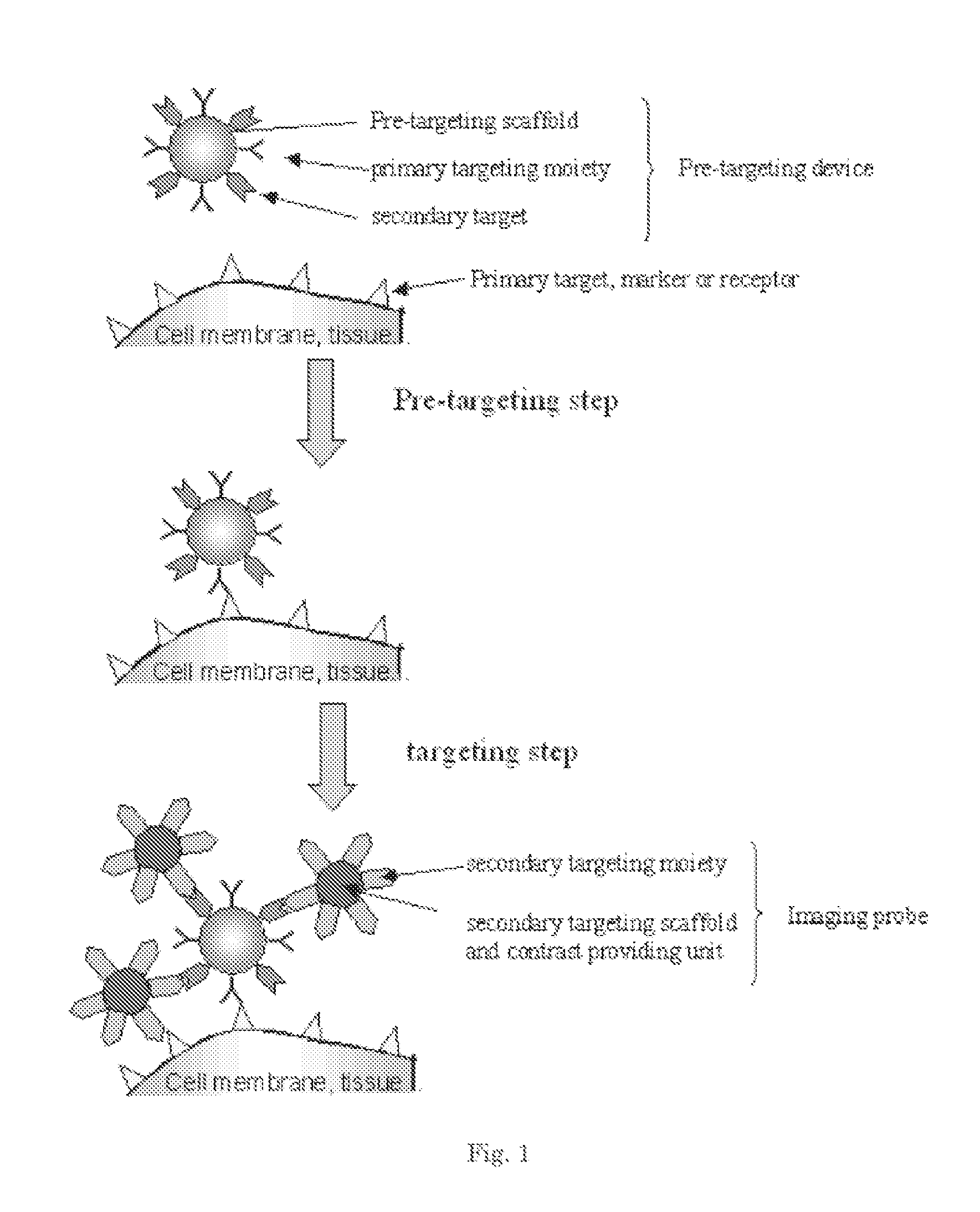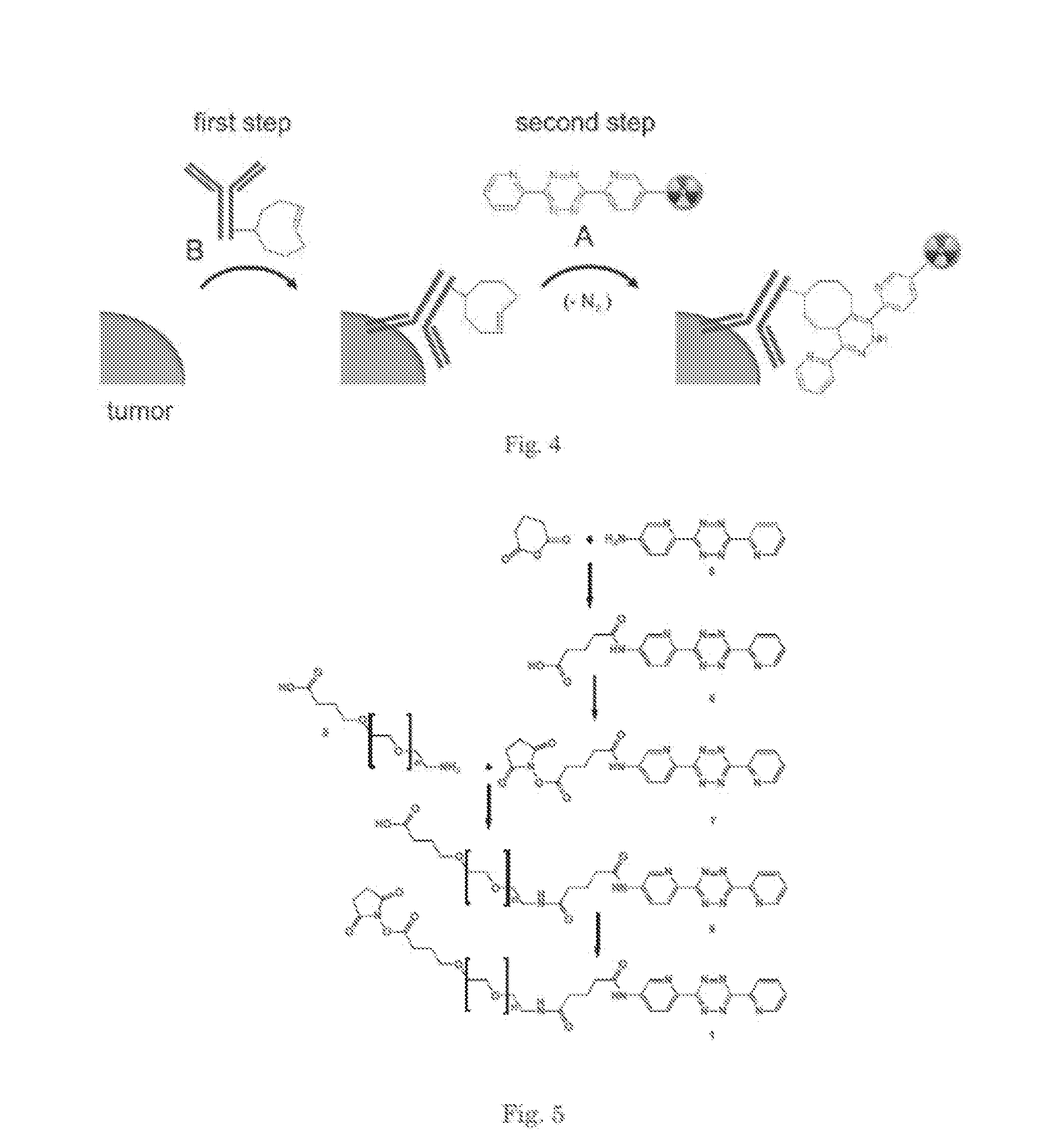Pretargeting kit, method and agents used therein
a technology of pretargeting and kit, applied in the field of pretargeting methods, can solve the problems of pre-targeting approaches, small probes, and remained out of reach
- Summary
- Abstract
- Description
- Claims
- Application Information
AI Technical Summary
Benefits of technology
Problems solved by technology
Method used
Image
Examples
example 1
[0133]As an example to link the tetrazine derived moiety to an antibody as outlined in FIG. 3a, a molecule 1 (see FIG. 5) is prepared. An example of a corresponding probe 2, derived from E-cyclooctene, is presented in FIG. 6. Both molecules contain PEG chains. Molecule 1 comprises an N-hydroxysuccimidyl moiety, that is used to couple the molecule with amino groups present in the antibody. The DOTA derived moiety in 2 can be used to carry a rare earth metal ion such as Gd for MR imaging or Lu-177 for nuclear imaging and therapy (SPECT).
[0134]The synthesis of 1 is outlined in FIG. 5. The starting tetrazine derived molecule 5 is made according to Blackman et al. (Blackman, M L; Royzen, M; Fox, J M, Journal of The American Chemical Society, 2008, 130 (41), 13518-19). It is converted to the acid 6 by reaction with glutaric anhydride followed by formation of its N-hydroxysuccimidyl ester 7. This N-hydroxysuccimidyl ester is used to form acid 9 by reaction with the commercially available (...
example 2
[0136]This example illustrates the inverse pair of molecules of Example 1, The E-cyclooctene derivative 3 meant to form the pretargeting moiety after conjugating to the antibody is shown in FIG. 7. The tetrazine / DOTA derived probe 4 that can serve as the Effector Probe as outlined in FIG. 3b, is shown in FIG. 8.
[0137]E-cyclooctene derivative 3 is formed by reaction of the commercially available (IRIS biochem) PEG derivative 8 (see also FIG. 5) with N-hydroxysuccimidyl ester 14 to form acid 19, followed by formation of the N-hydroxysuccimidyl derivative out of this acid (FIG. 7).
[0138]The synthesis of the tetrazine / DOTA derived probe 4 is outlined in FIG. 8. This probe is made by reaction of the DOTA and PEG derived amine 18 (see FIG. 6) with N-hydroxysuccimidyl ester 7 (see FIG. 5).
example 3
[0139]This example is illustrated in FIG. 9, which presents a scheme for the synthesis of (E)-2,5-dioxopyrrolidin-1-yl 1-(4-((cyclooct-4-en-1-yloxy)methyl)phenyl)-1-oxo-5,8,11,14,17,20,23,26,29,32,35,38-dodecaoxa-2-azahentetracontan-41-oate (TCO-O-PEG10-N-hydroxy succinimide (NHS), major and minor isomer, 23a and 23b, respectively).
[0140]The compounds denoted (number)a represent E-major and the compounds denoted (number)b represent E-minor.
(E-major)-2,5-Dioxopyrrolidin-1-yl4-((cyclooct-4-enyloxy)methyl)benzoate (20a)
[0141](E)-Cyclooct-4-enol (10a, major isomer containing approximately 13% of the Z-isomer) was synthesized according to a literature procedure (M. Royzen, G. P. A. Yap, J. M. Fox, J Am Chem Soc 2008, 130, 3760).
[0142]A 60% sodium hydride dispersion (1.8 g, 45 mmol) was added to an ice-bath-cooled solution of 10a (1.70 g, 13.5 mmol) in 60 mL DMF. After stirring for 4 h at room temperature, 4-bromomethylbenzoic acid (3.85 g, 17.9 mmol) was added in portions and the suspens...
PUM
| Property | Measurement | Unit |
|---|---|---|
| Length | aaaaa | aaaaa |
| Length | aaaaa | aaaaa |
| Length | aaaaa | aaaaa |
Abstract
Description
Claims
Application Information
 Login to View More
Login to View More - R&D
- Intellectual Property
- Life Sciences
- Materials
- Tech Scout
- Unparalleled Data Quality
- Higher Quality Content
- 60% Fewer Hallucinations
Browse by: Latest US Patents, China's latest patents, Technical Efficacy Thesaurus, Application Domain, Technology Topic, Popular Technical Reports.
© 2025 PatSnap. All rights reserved.Legal|Privacy policy|Modern Slavery Act Transparency Statement|Sitemap|About US| Contact US: help@patsnap.com



